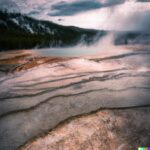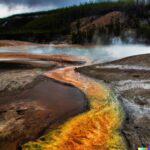Yellowstone National Park is home to some of the most famous geysers in the world, including the iconic Old Faithful. But have you ever wondered about the science behind these natural wonders?
In this article, we will explore the acidic nature of Yellowstone geysers. We’ll discuss what causes them to erupt, the role of acid in their formation, and how the acidic level is measured. Additionally, we’ll touch on the potential effects of acidic geysers on the surrounding environment and the measures in place to protect their delicate balance.
If you’ve ever been curious about the inner workings of these fascinating geological features, then this article is for you.
What Are Yellowstone Geysers?
Yellowstone geysers are unique hydrothermal features found in Yellowstone National Park, known for their spectacular eruptions and stunning geological formations created by volcanic activity.
The natural wonders of Yellowstone National Park are powered by the intense underground heat of the Yellowstone supervolcano, resulting in the iconic eruptions of hot water and steam. These geysers not only create a spectacular display, but also play a vital role in the park’s ecosystem by providing a habitat for thermophilic microorganisms that thrive in the extreme conditions.
Visitors are treated to a mesmerizing sight of vibrant colors and intricate mineral formations, offering a glimpse into the remarkable forces that have shaped the Earth’s landscape over millions of years. These geysers truly showcase the awe-inspiring power of nature.
What Causes Yellowstone Geysers to Erupt?
The eruptions of Yellowstone geysers are primarily caused by the interplay of volcanic activity, underground geothermal systems, and the accumulation of mineral deposits, all of which contribute to the build-up of pressure and the rise in temperature within the geyser chambers.
What is the Role of Acid in Yellowstone Geysers?
The role of acidic compounds in Yellowstone geysers is pivotal, influencing the chemical composition of the geothermal water, supporting unique microbial communities, and contributing to the environmental impact of these hydrothermal features.
These acidic components, including sulfuric and hydrochloric acids, play a crucial role in shaping the water’s chemistry, often resulting in lower pH levels and high concentrations of dissolved minerals.
This environment fosters the growth of specialized microbial life forms that have adapted to thrive in extreme conditions, contributing to the remarkable biodiversity within these geothermal ecosystems.
The presence of acidic compounds has implications for the surrounding environment, affecting soil composition and nutrient cycling, making the study of Yellowstone’s acidic components integral to understanding their broader ecological significance.
How Acidic are Yellowstone Geysers?
The acidity of Yellowstone geysers varies, with some exhibiting pH levels indicative of acidic conditions, primarily attributed to the presence of sulfuric acid and other chemical constituents, influencing the overall water chemistry of these hydrothermal features.
What is the pH Level of Yellowstone Geysers?
The pH levels of Yellowstone geysers range from acidic to neutral, influenced by the complex interplay of volcanic activity, temperature variations, and the chemical composition of the hydrothermal waters within the geysers.
The diverse pH levels found in Yellowstone’s geothermal features showcase their dynamic nature. The volcanic influence can release acidic gases into the hydrothermal system, affecting the pH levels of the geysers. Temperature fluctuations also play a role, with higher temperatures leading to increased acidity from the dissolution of acidic volcanic gases.
The chemical composition of the geothermal waters, including dissolved minerals and gases, also contributes to the variations in pH levels seen among the different geysers in the park.
How Does the pH Level of Yellowstone Geysers Compare to Other Geysers?
In comparison to other geysers worldwide, the pH levels of Yellowstone geysers often exhibit unique variations, influenced by the specific geothermal system and the characteristics of the thermal pools found in the region.
These distinctive variations in pH levels can be attributed to the diverse interplay of minerals, gases, and microbial activity within the geothermal system. The properties of the thermal pools, such as their composition and age, also contribute to these variations, resulting in a fascinating array of pH levels across different geysers in Yellowstone.
When compared to geysers in other locations, this showcases the intricate and dynamic nature of geothermal features and their influence on the surrounding environment.
What Are the Effects of Acidic Yellowstone Geysers?
The acidic nature of Yellowstone geysers has significant effects on the surrounding environment, influencing ecological balance, and contributing to the unique environmental impact of these hydrothermal features.
How Does Acidic Water Affect the Surrounding Environment?
The presence of acidic water in the vicinity of Yellowstone geysers can influence the geothermal system and support specific microbial communities, contributing to a distinct ecological impact on the surrounding environment.
This unique ecological phenomenon is vital in shaping the biodiversity and ecosystem dynamics around these geothermal features. Acidic water, with its low pH levels, interacts with the surrounding rock formations, resulting in a distinctive chemical composition that fosters the growth of extremophilic microorganisms.
These microbial communities play a crucial role in nutrient cycling and primary productivity, ultimately shaping the overall ecology of the geothermal region. As a result, the impact of acidic water on the geothermal system extends beyond its chemical properties, influencing the biological diversity and ecological processes within the area.
Can Acidic Yellowstone Geysers Harm Humans?
While the acidic nature of Yellowstone geysers poses environmental challenges, the direct harm to humans is mitigated by the specific chemical composition and temperature regulation of these hydrothermal features.
The chemical composition of the geysers is characterized by high levels of silica and metal ions. This creates a protective barrier against direct exposure, reducing the risk of burns and other thermal injuries. Additionally, the temperature regulation within these hydrothermal features prevents human contact with extremely hot water. These factors work together to significantly minimize the potential impact on human safety, allowing visitors to experience the unique geothermal wonders of Yellowstone with appropriate caution.
How is the Acidic Level of Yellowstone Geysers Measured?
The acidic level of Yellowstone geysers is measured through scientific research and comprehensive analysis of the water chemistry, utilizing specialized techniques to quantify and monitor the presence of acidic compounds within these hydrothermal features.
What Can Cause Changes in the Acidic Level of Yellowstone Geysers?
Changes in the acidic level of Yellowstone geysers can be influenced by a combination of natural factors, including volcanic activity, as well as potential impacts from human activity, both of which can contribute to fluctuations in the overall acidity of these hydrothermal features.
What Natural Factors Can Affect the Acidic Level of Yellowstone Geysers?
Natural factors such as volcanic activity, variations in temperature, and the deposition of mineral compounds can significantly impact the acidic level of Yellowstone geysers, leading to dynamic changes in their overall chemical composition.
Volcanic activity plays a crucial role in releasing gases and minerals into the hydrothermal system, impacting the geysers’ acidity.
Temperature fluctuations can influence the rate of chemical reactions, altering the geyser’s acidic nature. Mineral deposition from underground water sources introduces various compounds that contribute to the overall acidic balance within the geysers, creating an intricate interplay of natural influences.
Can Human Activity Affect the Acidic Level of Yellowstone Geysers?
Human activity, if not regulated, can potentially influence the acidic level of Yellowstone geysers, impacting the environmental balance and the integrity of the underlying geothermal system. This necessitates careful monitoring and conservation efforts to minimize adverse effects.
This impact can result from certain human actions, such as the introduction of pollutants and chemical runoff into the geyser’s surroundings. These activities can disrupt the natural equilibrium, leading to increased acidity levels within the geothermal features.
As such, it is vital to implement strict regulatory measures and ongoing observation to safeguard the delicate ecosystem. By understanding and addressing the implications of human presence, we can work towards preserving the unique and valuable geothermal resources in Yellowstone National Park.
How Can We Protect the Acidic Balance of Yellowstone Geysers?
Preserving the acidic balance of Yellowstone geysers necessitates the implementation of conservation measures and comprehensive monitoring efforts to safeguard the environmental integrity and the delicate geothermal system supporting these unique hydrothermal features.
What Measures are in Place to Monitor and Maintain the Acidic Level of Yellowstone Geysers?
Monitoring and maintaining the acidic level of Yellowstone geysers entail rigorous scientific research, environmental monitoring programs, and conservation initiatives aimed at preserving the unique chemistry and ecological balance of these hydrothermal features.
These efforts involve continuous water sampling and analysis to track any fluctuations in acidity levels within the geysers. Ongoing studies are conducted to understand the impact of geothermal activities on the surrounding environment.
Conservation efforts include implementing sustainable practices to minimize human impact, and promoting public awareness to foster responsible visitor behaviors. The collaborative work of researchers, park authorities, and environmental organizations plays a pivotal role in safeguarding the delicate equilibrium of these natural wonders.
What Can Individuals Do to Help Preserve the Acidic Balance of Yellowstone Geysers?
Individual efforts to preserve the acidic balance of Yellowstone geysers can include responsible conservation practices, raising awareness about environmental impact, and supporting initiatives aimed at the sustainable management of the underlying geothermal system sustaining these remarkable hydrothermal features.
Individuals can play a significant role in maintaining the delicate equilibrium of the geysers by actively engaging in responsible waste management, reducing carbon emissions, and promoting sustainable tourism in the region.
By advocating for the protection of the unique geothermal ecosystem and participating in educational programs, individuals can help ensure the long-term preservation of this natural wonder.
Frequently Asked Questions
What is the acidity level of Yellowstone geysers?
The acidity level of Yellowstone geysers varies, but it is generally between pH 3 and pH 5, making it slightly acidic.
How does the acidity of Yellowstone geysers affect the surrounding environment?
The high acidity of Yellowstone geysers can have a negative impact on plant and animal life in the area, as well as affect the water quality of nearby rivers and streams.
Why are Yellowstone geysers acidic?
Yellowstone geysers contain high levels of sulfuric acid, which is created when water and steam react with sulfur-rich rocks in the geothermal system.
Can the acidity of Yellowstone geysers change over time?
Yes, the acidity of Yellowstone geysers can fluctuate due to changes in the underlying geothermal activity, weather patterns, and other environmental factors.
Is it safe to swim in Yellowstone geysers with high acidity?
No, it is not safe to swim in Yellowstone geysers, regardless of their acidity level. The extreme heat and potential for sudden eruptions pose a serious danger to anyone in the water.
How does the acidity of Yellowstone geysers compare to other geothermal areas around the world?
Yellowstone geysers are among the most acidic geothermal features in the world, with only a few other locations, such as the Italian supervolcano Campi Flegrei, having a similar level of acidity.
Last Updated on January 25, 2024 by Jon Waraas – Originally Posted: January 25, 2024

I’m Jon Waraas, and I’ve been navigating the online world since 2006. By day, I’m the proud owner of some eCommerce gems, and by night, I’m the voice behind the adventures on Waraas.Com.
My heart, however, belongs to the wild beauty of Yellowstone National Park. I’ve got a collection of websites dedicated to sharing the wonders of this natural masterpiece. Oh, and did I mention? I’m currently building my own cabin inside the ghost town of Gilmore, Idaho – a cabin with tales to tell!
When I’m not immersed in the digital realm, you’ll find me lacing up my boots for a good hike or setting up camp under the star-studded sky.




